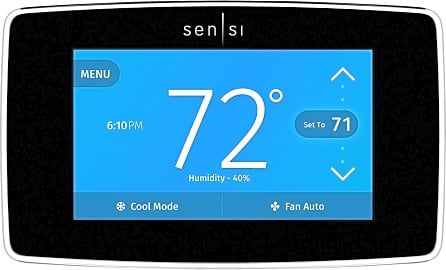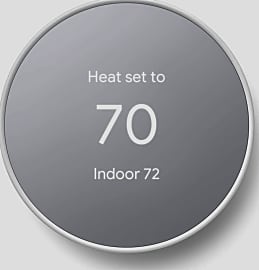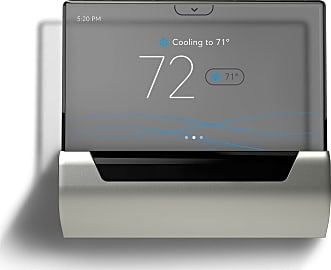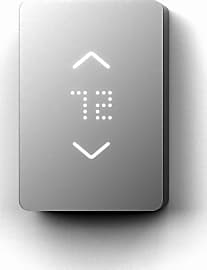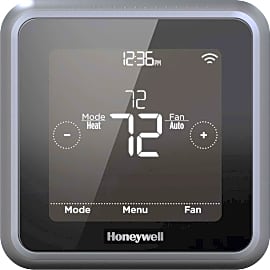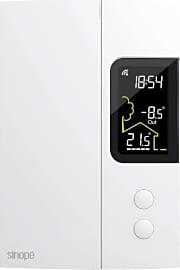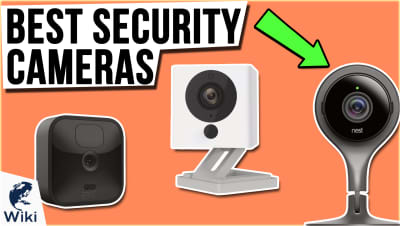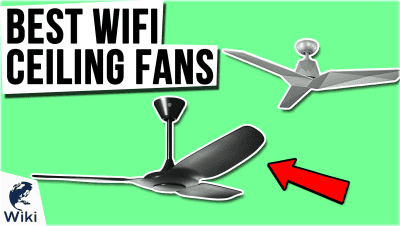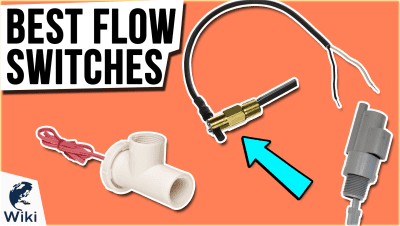The 10 Best Thermostats

This wiki has been updated 40 times since it was first published in February of 2015. If anything should be in a Goldilocks zone, it's your home. Fortunately, smart thermostats have made it easier than ever to keep your surroundings not too hot, not too cold, but just right, saving time, money, and energy in the process. Choose one of these sophisticated and intelligent Wi-Fi climate control devices to conveniently maintain the perfect ambient temperature year round. When users buy our independently chosen editorial selections, we may earn commissions to help fund the Wiki.
Editor's Notes
December 10, 2020:
As is typical of these fast-moving smart technology categories, it was a fairly busy round of updates, with some models being replaced by new versions, while others were eliminated altogether to make room for new additions.
We replaced Honeywell's T5 model with the Honeywell Home T5+, which is essentially the same thermostat, only now it’s packaged with an adapter that makes the device compatible with wiring configurations that lack a common conductor (often simply referred to as a C-wire). This should afford some peace of mind for users doing retro installations, but unfortunately, it does cost quite a bit more than the adapterless T5. The company has stated that it will no longer be offering the T5, but it was still available at the time of this update.
So, if you know that you’ve already got a common conductor in place, and the T5 is still available, then go ahead go with the original model, and save yourself some money. If you don’t have a common conductor in place, then consider the increase in price a good thing, because it’ll almost certainly cost significantly less than calling an electrician in to run that wire for you.
The Google Nest E was also still being offered at the time of this update, but according to the company’s website, it’ll soon be only available through professional installers. With that in mind, we decided to replace it with the Google Nest Thermostat, a new offering that’s now filling the Nest E’s position as a stripped down version of the Google Nest Learning Thermostat.
Besides some aesthetic differences – four choices of color compared to seven, a simple mirror display instead of a high-resolution screen, and a plastic housing instead of metal – the biggest difference between the two is that the basic model isn’t as intelligent as the premium model, in terms of learning your habits, and it can’t connect with remote temperature sensors. It also has a one-year warranty instead of two, but if all that doesn’t phase you, it is much more affordable, and it’ll still satisfy many user’s needs.
We also eliminated the Emerson Sensi, as our rankings already included the superior Emerson Sensi Touch ST75, and removed the Nuheat Signature, recognizing that an infloor-heat-specific thermostat would only be useful for a small portion of our audience. In their places, we added the Johnson Controls GLAS — a particularly smart-looking model with a slick OLED touchscreen; and the Sinopé TH1123ZB — a basic unit that offers line-voltage control of up to 3,000 watts of heating equipment. A 4,000-watt version of this offering is also available, and for a small increase in price, but, believing that 3,000 watts is plenty for most applications, we still decided to list the more-affordable option. Note that, while the TH1123ZB costs considerably less than the Mysa Smart, which is suitable for similar applications, it also requires the use of a hub, which will almost double your initial investment.
December 04, 2019:
Companies are constantly adding innovative new technology to their Wi-Fi thermostats, so we wanted to make sure to only include recently-released models when possible. Of course, in addition to having new technology and features, it was important that our selections perform well, too.
During this update, 70 percent of our list was either updated to a new version or completely replaced with a better model. One such example is the Ecobee Voice Control, which takes the place of its predecessor, the Ecobee 4. In addition to verbal control, other new features include Bluetooth audio streaming to an external speaker and dual-band Wi-Fi support. Another example is the Honeywell Home RTH9585, which takes the place of the Honeywell RTH9580. While the features of these two are almost indistinguishable, the former was released in 2016 and has a newer operating system, which means there is a better chance of firmware updates being supported well into the foreseeable future, whereas the latter came out in 2012.
While the Nest Gen 3 T3017US has been a top contender for years and is still a great choice for most homes, consumers who are looking to save some money, while still getting many of the same benefits may want to consider the Nest E T4000ES. Other than the number of HVAC systems they are compatible with, the main differences between these two models are the lack of a touchscreen display and Farsight feature in the Nest E.
If you have a line-voltage floor or baseboard heating system in your house, the only options on our list that support your needs are going to be the Mysa Smart and Nuheat Signature, as all of the rest are only suitable for low-voltage control.
Special Honors
Wyze Thermostat It may not look as impressive, or boast as many bells and whistles as some of the top-end competitors in this category, but you'll have a hard time beating the price of this unit from Wyze. It sports a simple, intuitive interface, and comes with many of the same, basic features as its pricier competitors, like energy-usage tracking, some smart-home compatibility and app control. wyze.com
Expanding Technologies
After that, you can sync it up with your home network and control your temperature from anywhere in the world.
If you've ever exited your car after a long drive on a cool evening and sat outside in it for a moment before gathering up your things and heading into your home, you might have noticed a sound like light metal beads popping up gently into the underside of your hood. That sound is actually produced by a variety of metal engine components cooling off, and shrinking as they do so.
You see, on that long drive, those same components expanded as the engine heated up, and now that you've come to a stop and all that steel has begun to adjust to the crisp night air, it gets smaller. That very property, called thermal expansion, is the driving force behind the traditional thermostat: as a piece of metal is heated or cooled, it will connect or disconnect a circuit, causing either your heater or air conditioner to activate until the temperature in the room was such that the metal returned to its former size. Similar devices were developed using gas, which expands and contracts faster then metal, resulting in a more accurate response.
Digital thermostats, on the other hand, which form the foundation of the Wi-Fi options on our list, use a slightly more complex mechanism, albiet one likewise sensitive to ambient heat and cold, called a thermistor. Depending on its temperature, a thermistor puts out a very specific electrical resistance that, when translated by a microcontroller, becomes a corresponding temperature readout on your thermostat's screen.
With that information at your fingertips, you can program your thermostat to activate either of your systems whenever the temperature gets above or below a certain point, as measured by the particular resistance put out by the thermistor. You can even integrate an electrical thermostat's clock function into the equation to create program cycles based on anticipated temperature fluctuations in the weather, or on schedules of occupancy, potentially saving you a boatload of money you'd otherwise spend heating or cooling an empty house.
All that an electronic thermostat has to do from there to become a Wi-Fi thermostat is to add the hardware capable of communicating that information to your smartphone or computer. After that, you can sync it up with your home network and control your temperature from anywhere in the world.
Everything Is Under Control
You might have noticed that a few of the larger tech companies in the world have been making forays into our home lives in the guise of digital personal assistants. Siri, the Apple iPhone personality, was certainly one of the first to hit the scene with any kind of splash, but as her power to control certain aspects of your life and home increases, so, too, does her competition. Her most effective competitors are Amazon's Alexa, Google Home, and the Nexia system by drilling giant Ingersoll Rand.
Her most effective competitors are Amazon's Alexa, Google Home, and the Nexia system by drilling giant Ingersoll Rand.
As you peruse the available Wi-Fi thermostats that we've evaluated, you'll see that some are compatible with one or more of these home automation systems, some are more interested in merely linking to your mobile devices, and others are actually part of their own brand of home control. If the thought of adding security cameras, humidity control, entertainment systems, and more to a single command center appeals to you, then you'll have to decide on which system you plan to place your chips. That, alone, will narrow down our list by a good degree.
After that, questions of aesthetics abound. Some of the thermostats on our list are clearly trying to look like something more suitable for a contemporary home than like any other electronic thermostat you might have seen debut in the late 1980s. Taking into account the style of your house, especially the room in which your thermostat will be installed, will guide you further on your quest toward the perfect selection.
Warm And Toast History
Nobody likes to shovel coal; it's heavy, it's dirty, and it smells strange. There's a reason bad kids get coal from Santa. There was a time, however, when we more directly relied on it than we do now. I don't mean to undercut the significance of our reliance on coal for our boundless consumption of coal-fired electricity; it's just that we all used to have to actually handle the stuff if we wanted to regulate the heat in our homes. We had to trudge miserably down into the basement and add some coal to a complicated furnace adorned with mysterious valves, drafts, and dampers, whereas now we simply click a few buttons.
Nobody likes to shovel coal; it's heavy, it's dirty, and it smells strange.
This is largely thanks to Andrew Ure, a Scottish chemist who hated coal even more than Al Gore, and who invented the first bi-metallic thermostat back in 1830. The invention took a long time and a chronically chilly professor from Wisconsin to gain popularity, but by the turn of the century, thermostats were in heavy use for a variety of industrial applications, and–slowly, but surely–they began to filter into people's homes.
In the 1980s, everything that could be converted from an analog mechanism to a digital component was so converted, and the thermostat was among the most welcome of adjustments. Bi-metallic and gas-bellows units had a tendency to lag and provide rather inaccurate readings, but their digital counterparts proved to be much more precise. They also offered flexible and exact programming options to consumers for the first time.
Around the same moment, a revolution in home computing was underway that would eventually lead to the current state of the global internet and its individually housed wireless hubs. It was a no-brainer for manufacturers to jump on the app bandwagon that exploded out of that revolution toward the end of the oughts, and Wi-Fi thermostats have only become more useful, and more deeply integrated into an entire home's automation, ever since.



